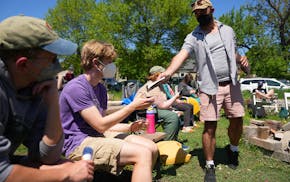COVID-19 deaths have not yet increased in Minnesota following increases in coronavirus infections and hospitalizations, raising hopes that the state's broadening vaccine shield will reduce the severity of the latest pandemic wave.
While the Minnesota Department of Health on Tuesday reported seven more COVID-19 deaths, no more than four deaths have occurred on any single date since June 12, according to preliminary state data. The seven-day average has been at or below two deaths per day since July 6, despite the emergence of the delta coronavirus variant that has caused COVID-19 hospitalizations in Minnesota to more than triple from 90 on July 14 to 333 on Monday.
State leaders cautioned against overconfidence because increases in COVID-19 deaths have come weeks after spikes in infections and hospitalizations in previous waves.
"Although we're in a fourth wave of this, the vaccine effectiveness is going to make this less severe for the hospitalizations than prior waves, even though the acuity and the burden of it is substantial," said Dr. John O'Horo, a Mayo Clinic infectious disease and critical care specialist.
Minnesota appears far from a peak, though, with high COVID-19 levels in Southern states creeping north. Counties in Minnesota with high or substantial viral transmission increased from 14 two weeks ago to 71 Tuesday, according to the Centers for Disease Control and Prevention.
For the third reporting day in a row, the state detected more than 1,000 new coronavirus infections — although the 1,690 infections reported Tuesday were from the entire weekend. Minnesota has reported 620,591 infections overall.
O'Horo said people must remain cautious despite the lack of COVID-19 deaths, and that it will take more vaccinations and mask-wearing in high transmission areas to blunt the wave that is being fueled by the fast-spreading delta variant.
"The vaccine remains one of the most potent tools we have to bring this back under control," he said. "Even though people who are vaccinated can still get infected and can still potentially transmit to others, they do that at a far lower rate and are far, far less likely to end up hospitalized or having a complication from COVID-19."
Minnesota has reported 7,705 COVID-19 deaths, with 88% involving people 65 or older. The state since July 1 has reported 106 COVID-19 deaths but only 49 that occurred in July — with two occurring in August and the rest occurring in earlier months and needing more time to verify and officially report.
Minnesota's death toll in July is the lowest of any month since March 2020, but that is a preliminary total with some deaths yet to be reported.
In previous waves, infections first circulated among younger and more mobile people at lower risk of severe COVID-19 before reaching older individuals and people with chronic health problems who are at higher risk, said Dr. Cameron Berg, an emergency medicine physician at North Memorial Health.
That can delay the increase in COVID-19 deaths along with the prolonged lifesaving efforts in hospitals, Berg said. "Even though COVID is a relatively rapid respiratory disease, the deaths actually occur after fairly protracted hospital courses — weeks after the onset of illness."
Berg and O'Horo said the lack of COVID-19 deaths in Minnesota this month also reflects good medical care that can be maintained while hospital resources are adequate, but they worried that survival rates could decline if infections surge and hospitals are overwhelmed. Minnesota suffered its largest one-day loss — 86 COVID-19 deaths on Dec. 3 — four days after hospitalizations peaked at 1,864.
COVID-19 care "is made much, much more complicated and therefore I think less effective as health systems start to get strained," Berg said. "I think you are seeing that in Florida now, for example. They don't have ECMO [heart-lung bypass] machines, so that changes the calculus."
Minnesota's COVID-19 death rate for the past week ranks 16th among states. Gov. Tim Walz credited vaccination progress for that rate but said he was concerned about the rapid rise in hospitalizations.
"While we've had a 300% increase and we're at the highest hospitalization totals there have been since May, we've still got a lot of space," Walz said. "In the state of Arkansas, there are eight ICU beds available. That's the situation there. That's not the situation here."
More than 3.2 million people 12 and older have received at least a first dose of COVID-19 vaccine — 68.4% of Minnesota's eligible population.
Vaccinations have increased in response to the delta variant and calls to have eligible children vaccinated before the start of school. A new $100 incentive has helped — with 31,475 new vaccine recipients registering in the past week after getting their shots.
More than 55,000 vaccine doses were administered in the week beginning Aug. 1. That is the highest weekly total in at least a month, though it remains below the daily number of doses administered at one point earlier this year.
More than 91% of senior citizens have received first doses. That is why hospitals are reporting a higher rate of younger patients, Berg said.
"The demographics have shifted throughout each of the surges, but even more so with the delta surge," he said. "We're seeing a median age of illness, even in the hospitals, that is quite a bit lower than it ever has been."
Breakthrough infections have been identified in only 0.19% of fully vaccinated Minnesotans, and severe illness rates are even lower in this group. The 57 fatal breakthrough infections make up .002% of the nearly 3 million fully vaccinated Minnesotans.
Even so, it is premature to conclude that the latest wave won't be as lethal, said Kris Ehresmann, state infectious disease director. "The higher level of vaccination coverage helps us, but I would not want to make a definitive assessment at this point."
Another looming question is whether Minnesota will follow the course of countries such as England and India, which experienced severe but quick peaks in their delta variant waves.
O'Horo said he hoped that people would be motivated by the potential for fewer deaths and a quicker wave — which could shorten the duration of mask requirements or restrictions at schools and events.
"We're looking at a rough few weeks ahead with the delta surge," he predicted, but "with the vaccine, we really do have light at the end of this particular tunnel."
Staff writer Briana Bierschbach contributed to this report.

Minnesota sites serving people who use drugs could 'save lives.' Funding cut could block plan.
New Minnesota GOP leaders seek peace with party's anti-establishment wing

Who is Republican Lisa Demuth, Minnesota's first House speaker of color?

